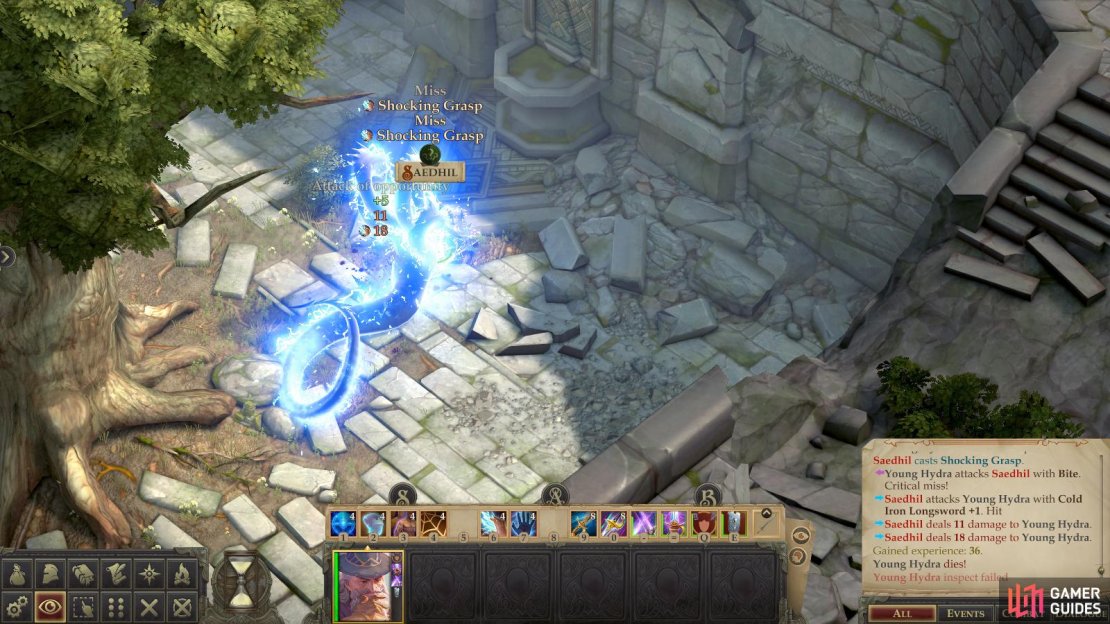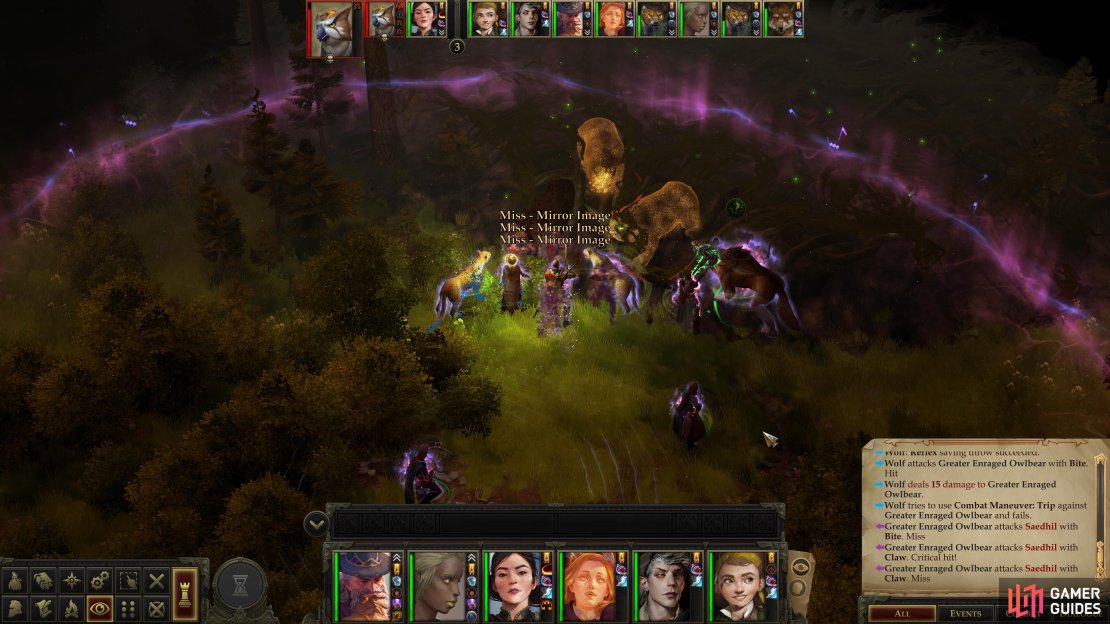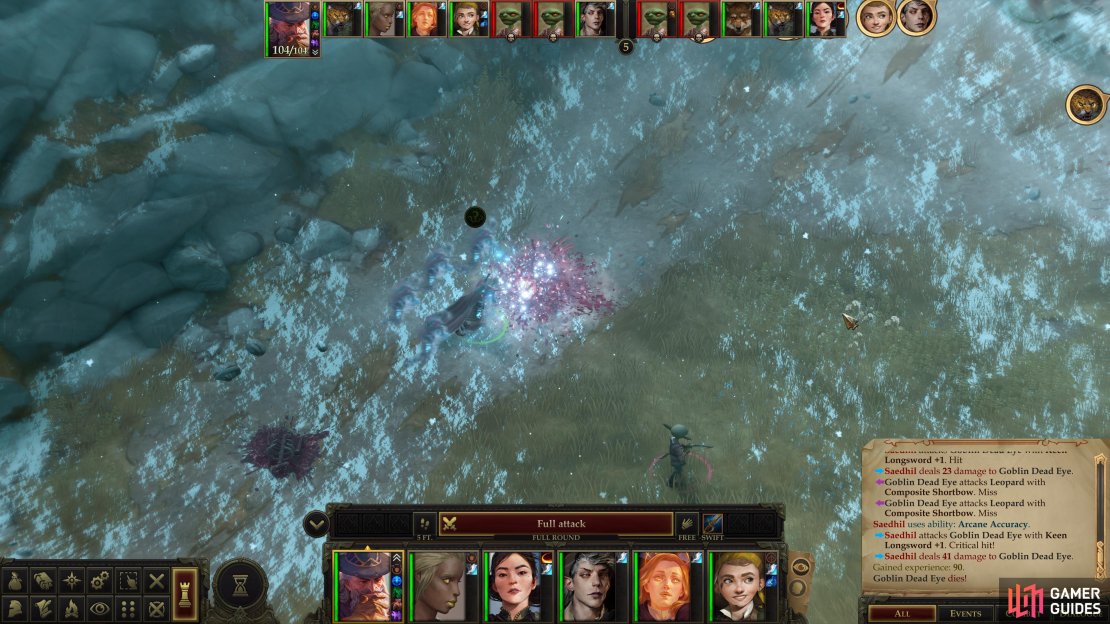On the main page for the Tank you’ll find information about various build information you need to know when first creating your character, while on this page you’ll find a level-by-level guide to advancing them, and information on how the character’s playstyle will change over time, when applicable. For the sake of brevity, we’ll base this information based on the build we used and we won’t quibble too much over minor variations which are possible.
| The Tank | Starting Characteristics |
|---|---|
| Strength | 7 |
| Dexterity | 18 |
| Constitution | 14 |
| Intelligence | 7 |
| Wisdom | 8 |
| Charisma | 19 |
| Race | Human |
| Bloodline | Draconic (Red) |
| Alignment | Lawful Good |
| Level | Class | Feats/Class Abilities | Spells | Misc. |
|---|---|---|---|---|
| 1 | Magus (Eldritch Scion) 1 | Dodge, Weapon Finesse | Grease, Shield | – |
| 2 | Monk (Scaled Fist) 1 | Crane Style | – | – |
| 3 | Magus 2 | Weapon Focus (Longsword) | Shocking Grasp | – |
| 4 | Magus 3 | Arcane Accuracy | True Strike | Mage Armor (Magus Bonus) |
| 5 | Magus 4 | Slashing Grace: Longsword | Glitterdust, Mirror Image | – |
| 6 | Magus 5 | Outflank | Web | Resist Energy (Magus Bonus) |
| 7 | Magus 6 | Crane Wing, Enduring Blade | Frigid Touch | – |
| 8 | Magus 7 | – | Reduce Person, Displacement, Haste | Dispel Magic (Magus Bonus) |
| 9 | Magus 8 | Dazzling Display | Fireball | – |
| 10 | Magus 9 | Ghost Blade | Vampiric Touch | Fear (Magus Bonus) |
| Level | Attributes |
|---|---|
| 1 | Str 7, Dex 18, Con 14, Int 7, Wis 8, Cha 19 |
| 4 | Cha 20 |
| 8 | Cha 21 |
| 12 | Cha 22 |
| 16 | Cha 23 |
| 20 | Cha 24 |
| Skills | ||
|---|---|---|
| Persuasion (max) | Mobility (3) | Use Magic Device (extra) |
There are all sorts of Magus builds out there, and many of them are quite good. So much so in fact that we couldn’t just choose one! See the Off-Tank for a Sword Saint variant, but this particular build is designed around one goal: to tank as effectively as possible. Naturally that means having a stupendously high Armor Class, but sometimes that’s just not enough. In a game where you can run into monsters with twenty-two Hit Dice when you yourself are barely pushing two digits, where said monster also has a Strength score many pen-and-paper deities would be proud of, you need to diversify your defensive options. That being the case, the Magus (Eldritch Scion) provides buffs that’ll not just boost our Armor Class, but give us useful boons like concealment (via Blur, Displacement, Greater Invisibility, etc.), Mirror Image and damage mitigators like Stoneskin.
Levels 1 - 4¶
Some characters come out the gate swinging, and keep pace the entire game. The Magus isn’t one of them. With a middling Base Attack Bonus and suspect armorless Armor Class, the Magus needs spells and class abilities to come into its own, and these aren’t gained immediately. The first four levels are the weakest the Tank will ever be, relatively, although they still manage to hit an Armor Class of 30+ by 3rd-level. Their offensive output, however, takes longer to develop.
1st-level¶
The first level is particularly rough, and the only time you should wear armor the entire game. Pair that with a Shield spell and… you’re about on par with your average warrior. Save that this character will hit for much less damage and land a hit less often. You can contribute to crowd control a bit with Grease - a spell which will be useful for quite a while - but you’re not the star damage-dealer, nor really much of a tank… yet.
2nd-level¶
By level two, things improve and get more complicated at the same time, as you dip into Monk (Scaled Fist) - the only diversion this class makes from Magus the entire game. The boons you’ll get are immediately noticed, but perhaps not immediately appreciated, as Scaled Fist will allow you to apply your Charisma modifier to your Armor Class… but only when you’re not wearing armor. Henceforth you’ll go unarmored, but the benefits gained from this are minor until you level up again. You’ll also pick up Crane Style, which will reduce your penalties for Fighting Defensively from -4 to -2 and give you an additional +1 Dodge bonus to Armor Class while doing so. From this time forward you should always be Fighting Defensively.
Initially the Magus’s damage output will be relatively low, but you can enhance this when necessary by using Spellstrike to inflict touch-range spells via melee attack.
3rd-level¶
When you hit level three, boost Magus up a level - you’ll be leveling up as a Magus the rest of the game. Things start to get better here, but this class isn’t firing on all cylinders just yet. You gain Mage Armor as a bonus spell and should pick Shocking Grasp as your chosen spell for the level. Why Shocking Grasp? Because more Magus class abilities are yours: Spell Combat and Spellstrike. These will allow you to cast a spell that normally requires a ranged touch attack (Corrosive Touch and Shocking Grasp both apply) and make a full attack option in the same round, discharging whatever touch-attack spell you cast should your melee attack hit. This will incur a -2 Attack penalty, but if you can land a hit it’ll increase the Magus’s damage output considerably. Spell Combat not only works with Spellstrike to turn this into a one-round affair, but you can also use Spell Combat to cast various spells (any spell which only requires a standard action) without losing out on any of your normal melee attacks on the same round. The benefits of being able to buff yourself while getting all your attacks in a round should be obvious to see, but being able to lob a Fireball while you carve up a foe is also satisfyingly flashy.
You’ll also get your third and final rank in Mobility this level, which will increase your Fighting Defensively bonus to +4 Armor Class. Nice. With the combination of Mage Armor, Shield, Fighting Defensively and your Dexterity and Charisma modifiers, your Tank should have an Armor Class of 30+, which will only improve as you start stacking various bits of Armor Class boosting gear (Amulet of Natural Armor, Ring of Protection, etc.). Not a bad spot to be in by level three.
4th-level¶
The final “weak” level of this build, there’s not much movement here save for the acquisition of Arcane Accuracy, which you can use to boost your Attack roll by a number equal to your Charisma modifier. This is a pretty significant boost, and can offset penalties for Spellstrike and Fighting Defensively when you just really need to land a hit. You’ve also burned through the best 1st-level spells for this class, but True Strike will have enduring utility as an Attack booster (remember, you can cast this while keeping your attacks via Spell Combat).
Levels 5 - 10¶
The Tank excels in rendering enemy aggression futile, both through a combination of a high Armor Class and illusion spells.
5th-level¶
Level five is when the indecisiveness and misery ends for this build. Okay, we’re being a bit dramatic here - it was never that bad, just… underwhelming. With the acquisition of Slashing Grace: Longsword you’ll now apply your Dexterity bonus to your damage rolls. This should increase your damage per attack by +4 (or more, if you have stat-boosting gear). Hard to exaggerate how much this improves your combat effectiveness - it should all but double your average damage output per hit. These are the levels where you’ll see rapid growth, and it’s glorious. In addition, you’ll also gain two 2nd-level arcane spells; pick Glitterdust and Mirror Image, as the former is one of the best early-to-mid game debuffs available (blinding enemies effectively gives you concealment, while it can also remove the protections they gain from illusion spells) while Mirror Image will waste enemy attacks, protecting you during the rare occasions when enemies surpass your Armor Class.
6th-level¶
One of the slower levels in this phase of character development, the highlight is Outflank, which boosts your Attack Bonus from +2 to +4 when you’re flanking, and causes critical hits to grant flanking characters Attacks of Opportunity. Flanking if a fundamental aspect of combat in Pathfinder: Kingmaker, and you should strive to do it nearly every fight, especially if you have animal companions, summons and you’re playing on turn-based mode, all of which will make it easier to perform. Other than that, you’ll grab the Web spell at this level, which fills the same niche as the Grease spell - area denial.
While it’s not the primary function of The Tank, with enough levels and abilities they’ll become a downright competent damage-dealer in their own right.
7th-level¶
6th-level was a bit of a lull, but 7th-level is back to form with a significant boost in power for our Tank. First up, you’ll grab the feat Crane Wing here, which will give you a +4 Dodge bonus to Armor Class while Fighting Defensively with a free hand. This sort of setup is ideal for the Magus’s Spell Combat ability, making this perk a no-brainer that further boosts our already impressive Armor Class.
On top of that we’ll select the Enduring Blade Magus Arcana, which we can use to add significant utility to a core Magus ability, which has thus far gone under-utilized: Arcane Weapon Enhancement. You’ve had this for a while, but frankly, its effects and duration were both unimpressive enough that it really wasn’t a major factor in this build. Enduring Blade improves this ability to make it more noteworthy, allowing you to expend one extra point from your Arcane Pool to increase the duration from the standard one minute to one minute per Magus level. From the outset, this buff will last seven minutes, which is enough time to clear a significant portion of any level.
Arcane Weapon Enhancement will boost the enhancement bonus of your weapon (up to a total maximum of +5), giving you a +1 bonus to Attack and damage at Magus levels 1-4, +2 at levels 5-8, +3 at levels 9-12, +4 at levels 13-16 and finally +5 at level 17+. Again, this stacks with the weapon’s base enhancement bonus, but the maximum is +5, so once you start getting your hands on +3, +4 and +5 weapons, the gains from this will diminish. Fortunately, you’ll gain other properties you can add to your weapons via Arcane Weapon Enhancement as you level up, including Keen (improves Critical Hit Threat Range), Flaming (+1d6 fire damage), Frost (+1d6 cold damage), and Shocking (+1d6 electrical damage), among others. These properties do not stack with any similar benefits on the same item (a Keen Longsword doesn’t benefit from adding Keen via Arcane Weapon Enhancement), and adding more properties will deplete your Arcane Pool faster, but the increase damage output (roughly +3.5 damage per elemental property added per attack) is one of the final boons needed to bring the Magus up to snuff, offensively.
There’s no reason why you shouldn’t be using Arcane Weapon Enhancement during every major battle and in every dungeon going forward, although the exact properties you apply will vary depending on what weapon you have, what enemies you’re facing and how many point you have to expend from your Arcane Pool.
8th-level¶
This level is something of a lull in terms of class abilities and feats, but it’s still overall a power level, as our Tank will finally hit 7th-level as a Magus (8th-level overall), which grants them access to 3rd-level arcane spells. Hard to overstate how much this improves our party, although you’ll hopefully have had another party member gain access to these earlier. Before we get to the good stuff, however, you’ll get another 1st-level spell, a well that’s been running dry for a while. There’s still a bit of good stuff to pick up here, however, so grab Reduce Person, which is a buff you can cast on yourself to increase your Armor Class and your Attack by +2, (both from size and Dexterity modifiers). This will also lower your damage output slightly (our weapon gets smaller too), but for a Dexterity-based character, this damage dip will be offset by the damage boost we’ll gain from improved Dexterity.
As for our two new 3rd-level spells, grab Displacement and Haste. Haste is a no-brainer, the more characters who can cast this the better - it’ll give your entire party a +1 bonus to Attack rolls and Armor Class, doubles your movement speed, and gives you one extra attack per round. It’s such a huge offensive boon, in fact, that you should get used to casting it during every major battle after you acquire it - it’ll literally increase your offensive output by 50% when you first gain access to it, and the improved movement speed makes flanking a breeze. Displacement can’t really compete with a spell as game-changing as Haste, but it’ll give a target 50% concealment - a useful boon seeing as how Glitterdust will start showing its age before long.
9th-level¶
Another slow level. You’ll add Dazzling Display to your repertoire - although you won’t be able to make much use of it until you qualify for the Shatter Defenses feat as well as the Fireball spell. Fireball is somewhat straight-forward, it deals up to 10d6 fire damage in an area. You won’t be able to make use of it all the time, but once in a while it’ll make for a telling first strike, and with Spell Combat you can chuck these out while retaining all your melee attacks for the round. As you start gaining Dragonkind spells (an Eldritch Scion class ability) you’ll also gain resistance, then immunity to an element. Assuming you chose Draconic Bloodline Arcana - Red at the beginning, this will allow you to drop Fireball spells at your own feet without causing significant harm (although some consideration is still needed for your allies). This is a ways off, however.
10th-level¶
The highlights for this level are the acquisition of the Ghost Blade ability, which will give you the Brilliant Energy and Ghost Touch properties you can apply via the Arcane Weapon Enhancement ability. Ghost Touch will negate concealment (a major nuisance from the middle of Chapter 2 on) while Brilliant Energy allows you to bypass Armor and Shield bonuses to Armor Class (but not Natural Armor). This will allow us to more easily strike armored foes, but does nothing for brutes relying on Natural Armor, and it won’t deal any damage to nonliving entities, be they constructs (golems) or undead. This was something of a tough call between Ghost Blade and Dimension Strike, as the latter allows us to resolve all melee weapon attacks as melee touch attacks for a turn (which would ignore all Armor, Shield and Natural Armor bonuses) and can actually still harm undead and constructs, but the cost and duration of the latter (2 Arcane Pool points for one round of effect) make the former (4 Arcane Pool points for a duration equal in minutes to your Magus level) more appealing, despite its limitations.
You’ll also pick up Vampiric Touch here, which can be combined with Spellstrike to inflict damage, just like other touch spells. This one, however, will deal up to 10d6 damage and give your Tank an equal number of Temporary Hit Points (not quite healing - think of it more as a damage buffer for your real Hit Points).



No Comments